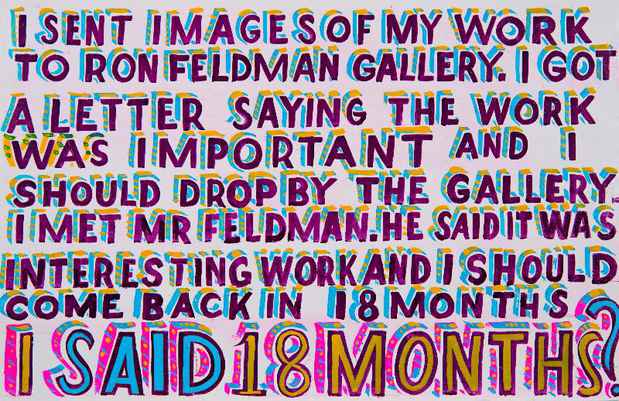“One Hundred and Forty Characters” Exhibition
Ronald Feldman Fine Arts

This event has ended.
Ronald Feldman Fine Arts presents One Hundred and Forty Characters, a group show of works dating from the early ‘70s through the present. All of the artists included in the exhibition incorporate text into their visual language.
In our instinctual effort to communicate with other human beings, we call upon both imagery and language to convey everything from our simplest animal needs to the most intricate complexities of the human psyche. Where one falls short, the other compensates. Though the platforms for communication have expanded in tandem with our technological advancements, the urge to relay an age-old content remains unchanged. From cave drawings to Egyptian hieroglyphs, through frescos and illuminated manuscripts, all the way to emoticon ridden tweets, we find visual images and/or the written word interwoven in our fabric of communication.
Not unlike an artist mixing paint, forming metal, or sculpting clay, letters can be broken down, re-built, and manipulated to create a unique commentary. This malleability of language is evident in the work of Joe Amrhein, Nancy Chunn, Arakawa and Sarah Hotchkiss. Joe Amrhein, a former sign painter by trade, physically layers pristinely painted multilingual words on mylar, representing in space the density of language. In 9/11 (2002-2004) and Sins of the Father (2002), Nancy Chunn deceptively employs cartoony pictograms and short phrases to convey disturbing subject matter. Her symbols simultaneously call to mind Egyptian hieroglyphs and modern day emoticons, linking a seemingly vapid present to a formative past. Arakawa, in his series The Mechanism of Meaning, challenges the viewers to test their perceived mental and physical boundaries. In Bound By Gravity We Imagine The Next Million Years (2011), Sarah Hotchkiss acknowledges the inevitability of time passing and the sense of humor and imagination necessary to cope with it.
Many artists in the exhibition derive their written material from outside sources, recontextualizing and ultimately repurposing the content. Sophie Miyamoto’s video,When the Angel of Death Kicks the Bucket of Life (2012), pairs an excerpt from a 1958 reading of “Finnegan’s Wake” with a phonetic spelling of the text flashing across the screen. The pitch shifting present in the audio recording is a result of the natural decay of the discarded cassette. Christine Hill’s hand-painted retro grocery posters, containing motivational quotes from a diverse selection of great minds from Bertrand Russell to Azar Nafisi, bring philosophy into the familiar realm of the marketplace. Bruce Pearson encrypts text mined from the mass media and the internet into thickly constructed and painted Styrofoam panels. The weight of the textural surface gives the words a physicality and depth that echoes their meaning. Jenny Holzer’s recontextualization of impactful language, sifted from various sources and placed on a variety of materials including benches, buildings, T-shirts and stickers, incorporates language and art into the public sphere. Viewers can pass by completely unaware, or stop and contemplate the often disorienting text. Eleanor Antin’s Library Science (1971), which appropriates library classification systems in order to categorize contemporary women, analyzes the way culture influences how we codify our surroundings.
Other artists in the exhibition use a combination of text and imagery to holistically explore the inner most crevices of their own psyches; the audience becomes engaged in what feels like an intimate dialogue. Ida Applebroog captures the deeply personal, yet painfully universal, with jarring phrases often incorporated into cartoonish images. The two mediums work to create an unsettling air, one enhancing the seriousness of the other. Stephanie Van Zandt Nelson opens up her private sphere to the public in her personal diaries, which she diligently kept throughout the course of her disquieted life. Edwin Schlossberg presents a series of poems which are cut into brass stencils. Hung away from the wall, the plates create shadows of the text, prompting the viewer to contemplate the context and how it changes the meaning of the words. The seemingly more detached statements painted by Bob and Roberta Smith are based on personal events, revealing the undercurrents that link all human experience. These artists explore the confluence of image and the written word, as an evolving tool of communication.
The exhibition is curated by staff members Scott Vincent Campbell and Amy Silver.
[image: Bob and Roberta Smith “Important Work” (2010) sign writer’s paint on board, 12 x 18 1/2 in.]
Media
Schedule
from June 01, 2013 to August 02, 2013
Opening Reception on 2013-06-01 from 18:00 to 20:00
Artist(s)
Joe Amrhein, Nancy Chunn, Arakawa, Sarah Hotchkiss, Sophie Miyamoto, Christine Hill, Bruce Pearson, Jenny Holzer, Bob and Roberta Smith et al.